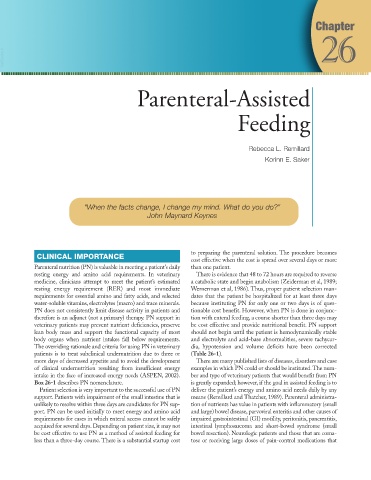Page 463 - Small Animal Clinical Nutrition 5th Edition
P. 463
Chapter
26
VetBooks.ir
Parenteral-Assisted
Feeding
Rebecca L. Remillard
Korinn E. Saker
“When the facts change, I change my mind. What do you do?”
John Maynard Keynes
to preparing the parenteral solution. The procedure becomes
CLINICAL IMPORTANCE
cost effective when the cost is spread over several days or more
Parenteral nutrition (PN) is valuable in meeting a patient’s daily than one patient.
resting energy and amino acid requirements. In veterinary There is evidence that 48 to 72 hours are required to reverse
medicine, clinicians attempt to meet the patient’s estimated a catabolic state and begin anabolism (Zeiderman et al, 1989;
resting energy requirement (RER) and most immediate Wernerman et al, 1986). Thus, proper patient selection man-
requirements for essential amino and fatty acids, and selected dates that the patient be hospitalized for at least three days
water-soluble vitamins, electrolytes (macro) and trace minerals. because instituting PN for only one or two days is of ques-
PN does not consistently limit disease activity in patients and tionable cost benefit. However, when PN is done in conjunc-
therefore is an adjunct (not a primary) therapy. PN support in tion with enteral feeding, a course shorter than three days may
veterinary patients may prevent nutrient deficiencies, preserve be cost effective and provide nutritional benefit. PN support
lean body mass and support the functional capacity of most should not begin until the patient is hemodynamically stable
body organs when nutrient intakes fall below requirements. and electrolyte and acid-base abnormalities, severe tachycar-
The overriding rationale and criteria for using PN in veterinary dia, hypotension and volume deficits have been corrected
patients is to treat subclinical undernutrition due to three or (Table 26-1).
more days of decreased appetite and to avoid the development There are many published lists of diseases, disorders and case
of clinical undernutrition resulting from insufficient energy examples in which PN could or should be instituted.The num-
intake in the face of increased energy needs (ASPEN, 2002). ber and type of veterinary patients that would benefit from PN
Box 26-1 describes PN nomenclature. is greatly expanded; however, if the goal in assisted feeding is to
Patient selection is very important to the successful use of PN deliver the patient’s energy and amino acid needs daily by any
support. Patients with impairment of the small intestine that is means (Remillard and Thatcher, 1989). Parenteral administra-
unlikely to resolve within three days are candidates for PN sup- tion of nutrients has value in patients with inflammatory (small
port. PN can be used initially to meet energy and amino acid and large) bowel disease, parvoviral enteritis and other causes of
requirements for cases in which enteral access cannot be safely impaired gastrointestinal (GI) motility, peritonitis, pancreatitis,
acquired for several days. Depending on patient size, it may not intestinal lymphosarcoma and short-bowel syndrome (small
be cost effective to use PN as a method of assisted feeding for bowel resection). Neurologic patients and those that are coma-
less than a three-day course. There is a substantial startup cost tose or receiving large doses of pain-control medications that

